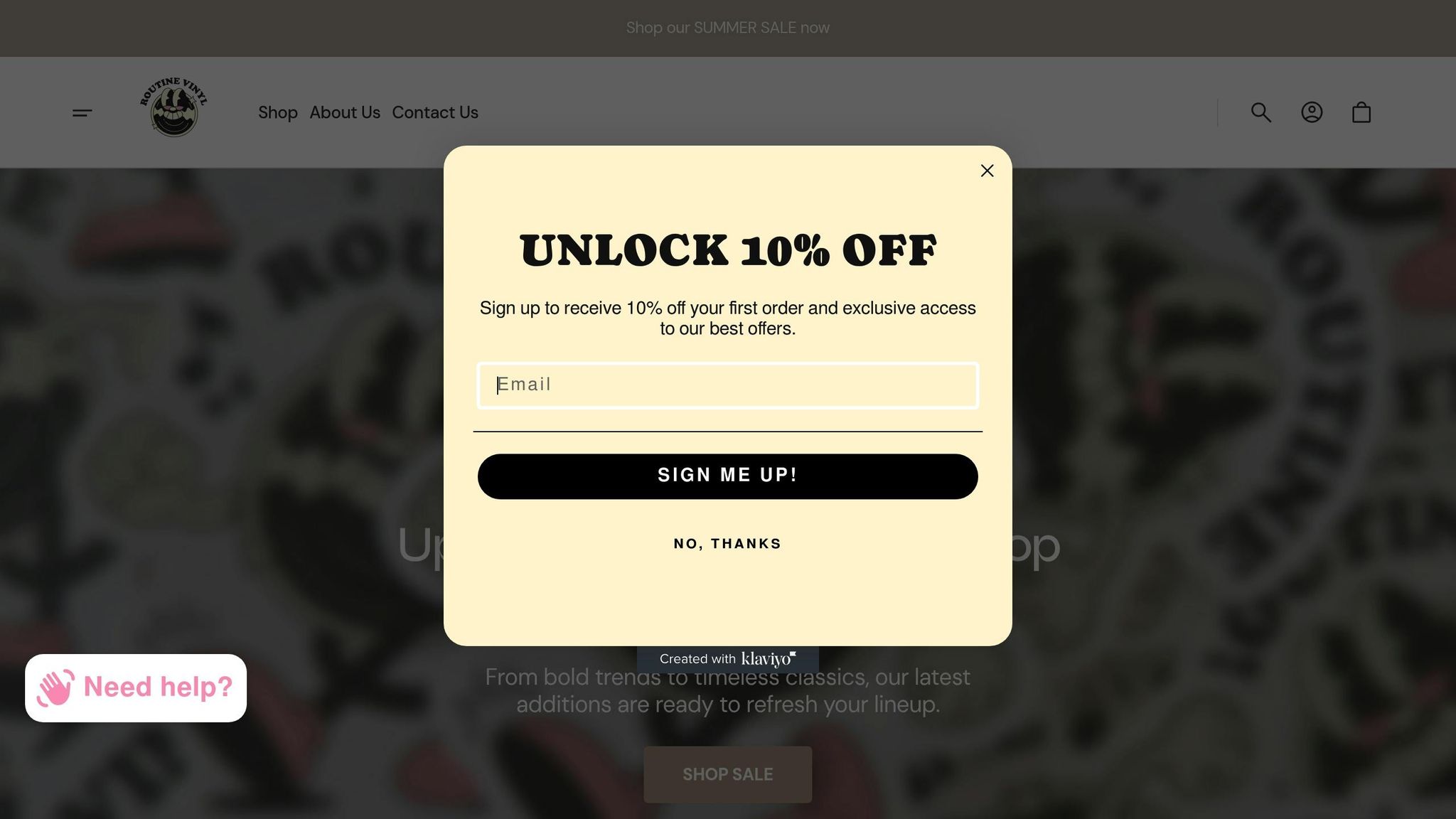Touching vinyl grooves might seem harmless, but it can seriously harm your records. The oils and dirt from your fingers transfer into the grooves, creating a sticky layer that attracts more dust and debris. This contamination increases friction during playback, leading to heat that can permanently fuse dirt into the grooves. Over time, this degrades sound quality, causing pops, clicks, and distortion. Worse, scratches from fingernails or improper handling can irreversibly damage the grooves, altering the music's structure.
Key Takeaways:
- Grooves are fragile: They hold the physical blueprint of sound and are easily damaged.
- Oils and dirt are harmful: Even clean hands leave residues that attract dust.
- Playback issues: Contaminated grooves increase friction, distort sound, and wear down the stylus.
- Prevention is simple: Handle records by the edges, keep them clean, and store them properly.
By following proper handling techniques, you can protect your records and enjoy clear, lasting sound.
How to Handle Vinyl Records Correctly - Vinyl 101
How Touching Vinyl Grooves Causes Damage
Touching the surface of a vinyl record does more harm than you might think. Every time your fingers come into contact with a record, you're leaving behind oils and debris that can compromise its quality. For anyone who loves vinyl, understanding how this happens - and the long-term consequences - is key to keeping your collection in top shape.
The Impact of Skin Oils and Dirt
Even if your hands look clean, they carry oils, sweat, and tiny particles that transfer directly into the grooves of a record. Once there, these contaminants create a sticky layer that attracts dust and airborne debris, essentially turning your record into a magnet for dirt. Imagine it as if you're applying a thin adhesive coating - suddenly, every speck of dust in the room clings to those affected areas.
But it’s not just the oils and dirt. Fingernails can add to the damage, scratching the delicate grooves if you’re not careful when handling your records. These scratches are more than just surface-level issues; they permanently alter the groove structure, leading to defects in sound quality that no cleaning method can reverse.
The damage starts the moment you touch a record. Even a quick, accidental touch leaves enough residue to kickstart a cycle of contamination. These oils and particles not only mar the surface but also set the stage for more severe, long-term issues.
Short- and Long-Term Effects of Groove Contamination
The problems caused by groove contamination go beyond what meets the eye - or ear. Both the record and your stylus suffer as a result.
In the short term, contaminants in the grooves increase the friction and drag on the stylus as it tracks the record. This extra resistance can reduce tracking precision, putting unnecessary stress on your turntable's cartridge and the record itself.
During playback, the situation escalates. The friction generates heat, which can cause dirt and particles to fuse into the vinyl grooves. What starts as a removable layer of grime becomes a permanent part of the record, altering its structure in ways that cleaning can’t fix.
The impact is immediate and audible. You’ll notice more surface noise, distortion, pops, and clicks. These aren't just minor annoyances - they’re signs of damage that worsen with each play.
Over time, the consequences multiply. The buildup of oils and debris, combined with increased friction during playback, gradually wears down the grooves, shortening the record's lifespan. Each play on a contaminated record accelerates this cycle, making the damage progressively worse.
And it’s not just your records at risk. Contaminated grooves can transfer debris to your stylus, reducing its performance and potentially leading to more frequent cleanings or even premature replacement.
The Science of Groove Damage
When oils and debris come into play, they wreak havoc on the delicate structure of vinyl grooves. These grooves, which might look like simple lines on the surface of a record, are actually incredibly detailed. They’re tiny, intricate landscapes filled with undulations that are physical representations of soundwaves etched into both sides of the groove walls.
The Microscopic Structure of Vinyl Grooves
To the naked eye, vinyl grooves seem smooth, but under magnification, they tell a different story. These grooves consist of peaks and valleys that mirror the original audio waveform. When viewed under an electron microscope at up to 1,000x magnification, their complexity becomes strikingly clear. Even at 400x, the undulating waveforms are visible.
What’s fascinating is that even perfectly clean grooves show irregularities under magnification. This is a natural result of encoding the intricate details of audio. However, their narrow and deep structure makes them incredibly vulnerable. A single speck of dust, a bit of dirt, or even skin oil can interfere with the stylus's ability to maintain proper contact with the groove walls. This disruption compromises the delicate balance necessary for accurate sound reproduction.
How Damage Affects Playback Quality
For vinyl playback to sound its best, the stylus must stay in seamless contact with the groove’s intricate patterns. When particles get stuck between the stylus and the groove walls, that connection is interrupted, leading to those all-too-familiar pops, clicks, and distortions. Physical scratches are even worse. They permanently alter the groove’s structure, erasing some of the musical details for good. This type of damage can cause distortion, dropouts, or even render sections of a record unplayable.
sbb-itb-c271774
Proper Handling Techniques for Vinyl Records
Now that you know how easily grooves can get damaged, it's time to learn how to handle vinyl records safely.
Best Practices for Handling Records
The number one rule when handling vinyl records? Always hold them by their edges. This simple habit keeps the grooves safe from the natural oils and dirt on your hands, which can harm sound quality over time - even if your hands seem clean.
Before touching any record, wash your hands thoroughly. This minimizes the risk of transferring oils, dirt, or debris that could cause skips or distortions in playback.
When removing a record from its sleeve, use one hand to gently hold the sleeve opening while carefully supporting the record by its edge with the other. Once it's out, continue to handle the record only by its edges as you place it on the turntable. Be gentle - applying too much pressure or bending the vinyl can lead to damage. For added protection, consider wearing nitrile gloves or finger cots.
These techniques ensure your records are handled with care, setting you up for a better listening experience.
Tips for Safe Handling During Playback
Avoid touching the grooves at all costs - your fingers can leave oils that degrade the sound. When placing a record on the turntable, grip it only by the edge, make sure it’s securely seated, and wait until the platter stops spinning before lifting it straight up to prevent scratches.
Keep your turntable area clean and free of dust or debris that might transfer to your hands and, ultimately, to the record.
Creating a Clean Storage Environment
Proper handling is just one piece of the puzzle; how you store your records is equally important. To maintain sound quality and prevent long-term damage, combine careful handling with regular cleaning and smart storage practices.
Start with a daily dry brushing routine using a carbon fiber brush to remove surface dust and static buildup. For more thorough cleaning, schedule occasional wet cleaning sessions to tackle oils and deeply embedded dirt that a dry brush can’t reach.
When it comes to storage, keep your records upright in a stable environment with consistent temperature and humidity to avoid warping and mold. Swap out old paper sleeves for high-quality anti-static inner sleeves to reduce the risk of scratches and extend the life of your collection.
Routine Vinyls: Your Go-To for Vinyl Care

Routine Vinyls is all about helping you keep your record collection in top shape. They handpick records and share regular updates about new releases, ensuring you're always in the loop. Plus, they offer tips and guidance on proper record handling, so you can enjoy your collection for years to come. With their expert advice, you’ll get the most out of your vinyl, maintaining excellent sound quality and preserving your records' lifespan.
Get the Latest on New Releases
Sign up for their newsletter to stay informed about the newest releases and store updates.
Whether you're new to vinyl or a seasoned collector, Routine Vinyls is here to elevate your listening experience and celebrate the timeless charm of vinyl records.
Conclusion: Protect Your Vinyl and Enjoy Quality Sound
Vinyl records are crafted to deliver that unmistakable, warm sound we all love. But here's the thing - every time you touch your records, even if it seems harmless, your fingers leave behind tiny residues that can mess with the grooves. Over time, this buildup can subtly degrade sound quality, even if the effects aren’t immediately obvious.
The good news? Keeping your collection in great shape doesn’t require expensive gadgets or complicated techniques. It’s all about being consistent and careful. Handle records by their edges to avoid direct contact with the grooves, store them in a clean, dust-free environment, and treat them with care during playback. These small habits go a long way in preserving that crisp, vibrant sound that makes vinyl so special.
Whether it’s a rare first pressing or a fresh release, taking care of your records ensures every spin sounds as good as the day you got it. Respect the grooves, and they’ll reward you with years of incredible listening experiences.
FAQs
How do I clean a vinyl record that's dirty or has fingerprints on it?
To clean a vinyl record that's picked up dirt or fingerprints, you'll want to use a method that's gentle yet effective. Start by preparing a basin of warm water mixed with a small drop of mild dish soap. Stir it gently to combine. Carefully lower the record into the water, making sure to keep the label dry - water can damage it. Using a soft, damp record brush, clean the grooves by following their circular pattern. Afterward, rinse the record thoroughly with cool, clean water to remove any soap residue. Dry it by patting gently with a lint-free cloth, and then allow it to air-dry completely before playing or storing it.
What happens if you don’t handle or store vinyl records properly?
Improper care and storage can seriously harm your vinyl records over time. When you touch the grooves with your bare hands, oils and dirt can transfer onto the surface, affecting the sound quality. Stacking records flat instead of storing them upright creates uneven pressure, which can result in warping. And don't underestimate the impact of heat or humidity - both can warp the vinyl, and in some cases, even lead to mold growth that damages the record and its sleeve.
To preserve your vinyl collection, always handle records by their edges to avoid contact with the grooves. Store them vertically in a cool, dry area, away from direct sunlight or extreme temperatures. With the right care, your favorite albums can stay in excellent shape for years to come!
What tools can I use to keep my vinyl records in great condition?
To keep your vinyl records in great condition, it's worth investing in specialized cleaning tools that protect the grooves and improve sound quality. Some must-haves include carbon fiber brushes to sweep away dust and reduce static, record cleaning solutions for a deeper clean, and stylus cleaners to maintain your needle’s performance.
For more intensive care, consider vacuum-based cleaning systems or all-in-one cleaning kits that come with brushes and cleaning fluids. These options can help extend the life of your records and keep the sound as crisp as the day you bought them.


